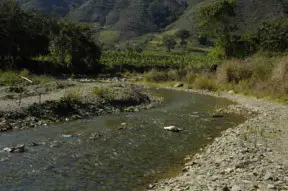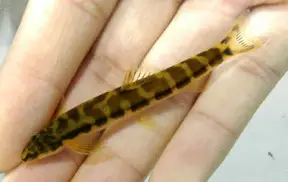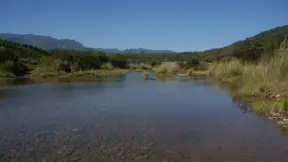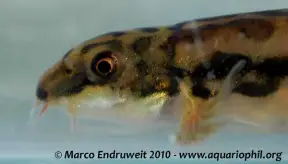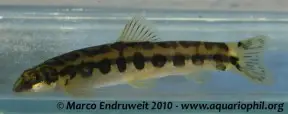Schistura kloetzliae
Etymology
Schistura: from the Greek schizein, meaning ‘to divide’, and oura, meaning ‘tail’, in reference to the caudal-fin shape of many species.
kloetzliae: named for Antoinette Kottelat-Kloetzli, ‘in appreciation for her help and support’.
Classification
Order: Cypriniformes Family: Nemacheilidae
Distribution
Type locality is ‘Mengla market, Mengla County, Xishuangbanna, Yunnan Province, China’, and this species is known only from the Mengla River system in Xishuangbanna prefecture, Yunnan province, southern China and Luang Namtha province, northern Laos.
The Mengla is a tributary of the upper Mekong basin and S. kloetziae has been collected from several of its tributaries including the Nanlahae, Mozhehe, and Nam Youan.
Habitat
Appears restricted to highly-oxygenated, fast-flowing riffles of small-to-medium sized streams. These typically contain clear water with substrates of gravel, rocks, boulders, and bedrock with no aquatic plants.
In a tributary of the Mozhehe River (see images) it was found in swiftly-flowing, shallow water of 10-20 cm depth alongside unidentified Opsariichthys and Schistura spp. On 5th January 2010 at 14:00 the water had a temperature of 20°C/68°F, pH 8.4, and 260 µS/cm, 130 mg/l (ppm; TDS).
Maximum Standard Length
40 – 47 mm.
Aquarium SizeTop ↑
An aquarium with base dimensions of 75 ∗ 30 cm or equivalent should be the smallest considered.
Maintenance
Likely to fare best in a tank designed to resemble a flowing stream or river with a substrate of variably-sized rocks, sand, fine gravel, and some water-worn boulders.
Use a powerful external filter, additional powerhead(s), or airstone(s) to achieve the desired flow rate and oxygenation and perform weekly water changes of 30-50 % aquarium volume.
Water Conditions
Temperature: 18 – 22 °C
pH: 7.0 – 8.5
Diet
Field observations suggest it to be a specialised micropredator feeding chiefly on invertebrate larvae which inhabit the interspaces between rocks.
In the aquarium it should accept dried foods of a suitable size but should not be fed these exclusively.
Daily meals of small live and frozen fare such as Daphnia, Artemia, bloodworm, etc., will result in the best colouration and condition
Behaviour and CompatibilityTop ↑
Unreported.
Sexual Dimorphism
Unreported.
Reproduction
Unreported.
NotesTop ↑
Has not yet been maintained in aquaria as far as we know.
It can be distinguished from congeners by the following combination of characters: unique colour pattern consisting of a pale yellowish brown body colour, with a series of large black blotches along the lateral line superimposed over a greyish axial stripe, each of them connected with blotches along the dorsal midline; blotches on dorsal midline are more or less connected to each other forming an irregular stripe; a black bar anterior to extremity of caudal peduncle; a short black bar on lower half of caudal-fin base; a black spot near the base of the uppermost 3 principal caudal-fin rays; two vertical rows of black spots on the caudal-fin rays; one row of spots on the dorsal-fin rays, one row of faint spots on anal and pectoral-fin rays; both lips finely pleated; upper lip with a median incision; lateral line almost complete; 8+8 branched caudal-fin rays.
Schistura is the most species-rich genus among nemacheilid loaches with some 190 members and it continues to grow with over 100 having been described since 1990.
It may represent a polyphyletic lineage and is often arranged into a number of loosely-defined species ‘groups’, some of which are quite dissimilar to one another.
Among these are an assemblage in which some or all of the body bars are vertically split and another which exhibit reductions in body size (adult size <50 mm SL), the number of pelvic and pectoral-fin rays and often the number of caudal-fin rays and lateral line length, for example.
Some species, such as S. geisleri, also appear to be unrelated to any of the others.
Most inhabit flowing streams or areas close to waterfalls where there naturally exist high concentrations of dissolved oxygen, and a handful are troglobytic, i.e., cave-dwelling, in existence.
The latter have reduced pigmentation and are completely blind in many cases.
Schistura spp. are distinguished from other nemacheilids by a combination of morphological characters which include: a moderately arched mouth which is 2-3.5 times wider than it is long; a median ‘interruption’ in the lower lip which does not form two lateral triangular pads and can vary from smooth to furrowed in texture; diverse colour pattern but usually dark with relatively regular bars; usually a black bar at the caudal-fin base which can be broken into two spots or smaller bars; one or two black markings along the base of the dorsal-fin; lack of acuminate scales on the caudal peduncle; caudal-fin shape variable from truncate to forked but usually emarginate; presence or absence of a median notch in the lower jaw; clear sexual dimorphism in some species.
The family Nemacheilidae is widely-distributed across most of Eurasia with the Indian subcontinent, Southeast Asia and China representing particular centres of species diversity.
References
- Kottelat, M., 2000 - Journal of South Asian Natural History 5(1): 37-82
Diagnoses of a new genus and 64 new species of fishes from Laos (Teleostei: Cyprinidae, Balitoridae, Bagridae, Syngnathidae, Chaudhuriidae and Tetraodontidae). - Endruweit, M. (ed), 2012 - World Wide Web electronic publication, www.aquariophil.org: Accessed on 12.10.21
Aquariophil. - Kottelat, M., 2012 - Raffles Bulletin of Zoology Supplement 26: 1-199
Conspectus cobitidum: an inventory of the loaches of the world (Teleostei: Cypriniformes: Cobitoidei). - Kottelat, M., 2013 - Raffles Bulletin of Zoology Supplement No. 27: 1-663
The fishes of the inland waters of southeast Asia: a catalogue and core bibiography of the fishes known to occur in freshwaters, mangroves and estuaries. - Tang, Q., H. Liu, R. Mayden, and B. Xiong, 2006 - Molecular Phylogenetics and Evolution 39(2): 347-357
Comparison of evolutionary rates in the mitochondrial DNA cytochrome b gene and control region and their implications for phylogeny of the Cobitoidea (Teleostei: Cypriniformes). - Šlechtová, V., J. Bohlen, and H. H. Tan, 2007 - Molecular Phylogenetics and Evolution 44(3): 1358-1365
Families of Cobitoidea (Teleostei; Cypriniformes) as revealed from nuclear genetic data and the position of the mysterious genera Barbucca, Psilorhynchus, Serpenticobitis and Vaillantella.


